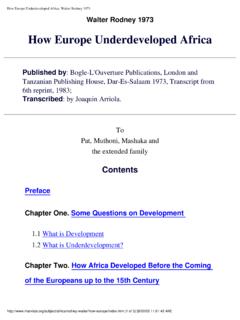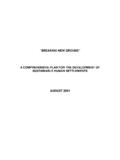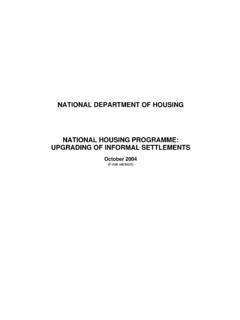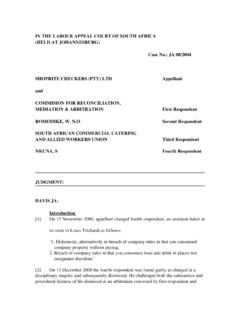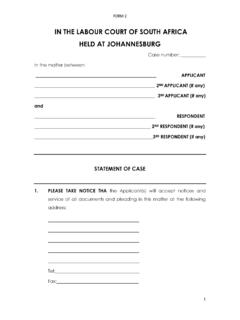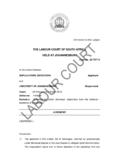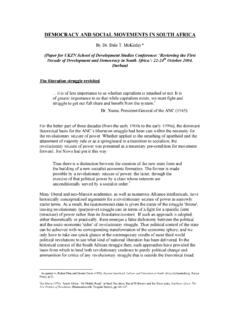Transcription of Framework for an Inclusionary Housing Policy (IHP) in ...
1 Framework for an Inclusionary Housing Policy (IHP) in south africa June 2007 Table of Contents 1 Introduction , , , ,,,, ,, , , 2 international Experience , , .. ~, , 3 Key Contextual Considerations in south africa , 4 lnclusionary Housing : Definitions , , , ,,, ,, , , , 4 1 lnclusionary Housing , ,,, 42 Affordable Housing , , , , , , , , , , , , , , , , , 5 Qualification Criteria , ,, , , , , , , , , , , . , , , , , , , , , , , ,, 6 Objectives of lnclusionary Housing in south africa , , , , , , , , , 7 Key Points of Departure, ,,, , , , , 8 The Essence of the Policy Proposal , , , , , , , , , , 8 1 The Voluntary Pro-Active Deal Driven (VPADD) Component , , , , , , , ,,, , , ,,,, 8 2 The Town Planning Compliant (TPC) Component.
2 , , ,,, ,, , 9 Dealing with Steep Price and Income Cliffs , , , , , 10 The lnclusionary Housing Prescription, , , , , , , , , , , , , ,, ,, 11 Incentives , , , , , , , , , , , , , , , , , , 111 Tax Benefits , , , ,, , ,,, , ,,, , ,, ,, IIZLand,, , ,,, , , , , , , , , , , ,, , , 11 3 Fast Tracking of Approval Processes, ,, , , 11 4 Development and Use Rights , , , 11 5 Bulk and link Infrastructure , , , , ,,, , . 11 6 Access to Government Housing Subsidies , ,, ,, 12 Economic Viability, , ,,, , , ,,,, 13 Marketing Risk ,, , , , , , , , , , , , , , 14, Allocations,,. , , , , ,, . ,, ,, , , , , , , , , , , , , .. , , , , ,, , 15 On Selling of lnclusionary Units, , , , , , , , ,,, ,, 16 Ongoing Market of Stock , , , , ,, , , , , , , , , , , , , , , , , , , , 161 Units for Purchase, , ,, , , , , , , ,,, , , , ,, , , , , , , , , , , , , , 162 Private Rental , , , , , , , , , , , , , , , , , , , , ,, 16 3 Social Housing , , , , , , , , , , , , , , , , , , , , , ,, ,, 17 Project Types and Design , , ,, ,, , ,, , , , , , , , ,, , , ,, ,, , , ,, , , , 18 Institutional Architecture, , ,, , , ,, ,, , ,, , , ,,, , , , 19 Legislative Requirements.
3 20 Arrangements for implementation , . , ,, , ,, , , , , 21 Alignment with other Policies and Programmes , , , ,,, , I Framework for an Incluslonary Housing Pollcy (IHP) In south Afilca I 1 ., INTRODUCTION In September 2005, at a Housing lndaba in Cape Town, government and key players in the private Housing development sector (including SAPOA) have signed a a Social Contract for Rapid ~ousing Delivery The contract basically states that "every commercial development including Housing developments that are not directed at those earning R1500 or less, spend a minimum of 20% of project value on the construction of affordable Housing (currently defined as Housing targeting households earning between R1500 and R8000 per month)
4 No position has however been legislated and no formal national Policy Framework exists In the first half of 2006 the NDOH commissioned and reflected on international experience regarding Inclusionary Housing Since then the NDOH has been engaging with the private sector to try to find a way of implementing Inclusionary Housing thinking in way which is appropriate in the south African context and which constitutes a "win-win" scenario for citizens, government and developers Several options have been presented and the Policy Framework outlined below has responded to what has been an energetic discourse about sometimes highly controversial issues It should be noted that imposing Inclusionary requirements outside of a national Policy Framework is neither illegal in south africa (unless national legislation and parameters are in fact put in place)
5 Or without precedent elsewhere in the world In the USA for example many local authorities have used the powers implicit in their planning ordinances to require Inclusionary provision entirely in the absence of State or National Policy or legislation However fragmented development of Inclusionary Housing policies has several potential shortcomings; . Many different policies can cause confusion in the marketplace .- both with respect to consumers and suppliers . Ill-consideredlnaive policies could potentially lead to developers choosing to exit the market (many localities don't have the capacities to develop appropriate Policy ) . Onerous local policies could cause developers to "flee" to other localities I Framework for an Inclusionary Housing Policy (IIIP) in south africa .
6 Too much "local flexibility" or "local discretion" can provide a breeding ground for corruption I or alternately for capricious and personality dependent coercion In south africa the idea of Inclusionary Housing has begun to capture the national imagination Some Provinces, for example Gauteng and W Cape, have formulated draft policies and are beginning to implement them Moreover many local authorities (for example Johannesburg and Ethekwini) are beginning to require developers to include affordable Housing in their projects The NDOH is concerned that some of the dangers of the fragmented development of Inclusionary Housing Policy mentioned above may already be evident in south africa and that there is a need to provide guidance and to set parameters regarding Inclusionary Housing , Thus this document outlines a strategy Framework for Inclusionary Housing in south africa 2.
7 INTERNATIONAL EXPERIENCE lnclusionary Housing policies can be found in many countries but largely in the developed world and the rapidly developing economies of south and East Asia (e g the USA; Ireland; Scotland, England; the Netherlands, Malaysia, China) In virtually all of these countries there is a vigorous private sector property development industry providing Housing for the middle and upper income sections of the population lnclusionary Housing policies have been introduced in an attempt to harness the energy of this industry and to leverage "affordable" Housing delivery off the delivery of Housing for middle and upper segments of the market Whilst there is a great deal of variation in the kinds of policies used.
8 Inclusionary Housing generally involves requiring developers of major greenfields project to make a proportion of the units available in the form of affordable Housing (a % of the number of units, or a % of the project value, or a % of the bulklcoverage allowances, etc) The California Inclusionary Housing Reader (2003) notes that in addition to the above, most Inclusionary programmes worldwide contain all or some of the following elements: Framework for an Inclusionary Housing Policy (IHP) in south africa . An exemption for small projects . Income or house price affordability criteria The provision of incentives by government (usually in the form of densrty bonuses or tax credit schemes)
9 Restrictions on resale of affordable units It must be stressed however that there is enormous variation from one context to another both with regard to the reasons for and the content of Inclusionary Housing policies As far as purpose is concerned in countries such as Malaysia and China the primary purpose has been delivery of affordable Housing at scale whereas in contexts such as the USA and the UK, the achievement of greater socio-economic balance and social inclusion has been at least as important as boosting the supply of affordable Housing stock In the USA for example Inclusionary Housing is also seen as an important tool for achieving greater racial integration and to counter racially exclusive processes of built environment creation In some contexts Inclusionary Housing is tightly linked to government subsidy programmes and involves partnerships between developers and social Housing institutions In other contexts (e g the USA)
10 There has been a tendency to avoid the linkage to subsidy as far as possible (in part because social Housing institutions have opposed it but also because developers have wanted to avoid having projects held up because they are stuck in subsidy queues) In some contexts Inclusionary Housing projects are driven centrally via national legislation (Malaysia) whilst in others Inclusionary Housing is embedded in local planning ordinances In some contexts Inclusionary Housing provisions are highly prescriptive and inflexible (China, Malaysia) whilst in others they allow are more permissive and allow much more flexibility (e g the UK) Whereas is most countries Inclusionary Housing policies are applied to projects, in some contexts they are applied at the level of towns and cities (e g Belgian and Dutch cities are given targets to achieve regarding the provision of affordable Housing by private developers) Framework for an Inclus~onary Houslng Pol~cy (IHP) In south Afr~ca As a general rule Inclusionary Housing programmes are generally considered to have been a success both with respect to promoting affordable Housing supply and in promoting social inclusion In a number of national contexts (and most notably the USA)



